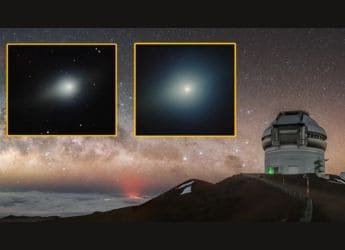- Home
- Science
- Science News
- Supernovas May Have Triggered Deadly Ancient Climate Shifts, and They Could Happen Again
Supernovas May Have Triggered Deadly Ancient Climate Shifts, and They Could Happen Again
Supernova explosions may have caused ancient climate disruptions and still pose risks to Earth’s atmosphere.

Photo Credit: European Southern Observatory
Massive stellar explosions may have disrupted Earth’s ancient climate and ozone layer
Earth's ancient climate was influenced by unexplained ‘mystery particles' from outer space. Explosive stellar events may be forecasted by analysing iron isotopes in interstellar dust. New research indicates that nearby supernovas, the giant death explosions of stars, may have upset the planet's atmospheric balance thousands of years ago. These bursts, creating torrents of high-energy radiation, may have triggered global cooling, wildfires, and mass extinctions, researchers have mentioned. By tracking down those cosmic footprints of the past, scientists say, they may even be able to learn more about the environmental hazards posed by future supernovas and be readier to deal with them.
Cosmic blasts from nearby supernovas may have eroded Earth's ozone layer and disrupted ancient climate systems, scientists say
As per a report by Space.com, supernovas occur when stars more massive than our sun collapse in on themselves under the force of their own gravity, leaving behind either black holes or neutron stars and ejecting extremely powerful radiation. If such a blast occurred within 30 light-years, researchers warn, it could strip away Earth's atmosphere entirely. But even explosions hundreds of light-years away, such as from Betelgeuse, 700 light-years away, could alter climate patterns and increase ultraviolet exposure on Earth.
Robert Brakenridge, a senior researcher at the Institute of Arctic and Alpine Research, studied 15,000 years of tree ring data and identified 11 spikes in radioactive carbon. These anomalies, he suggests, may be evidence of Earth being struck by cosmic radiation from past supernovas. “We have abrupt environmental changes in Earth's history,” Brakenridge pointed out. “We see these changes. So, what caused them?”
His model suggests that high-energy photons from supernovas could irradiate and destroy the ozone layer, allowing more ultraviolet radiation to reach Earth's surface, and erode the stratosphere, which stores a decent amount of methane, both crucial contributors to Earth's greenhouse gas regulation. The plunge in methane would have cooled the planet, possibly setting in motion climatic changes and die-offs of many species.
Although solar flares are another potential candidate for the carbon spikes, Brakenridge explains that more geological evidence, such as ocean sediment and ice cores, could tie the supernovae to these events. Insight into this relationship could assist scientists in predicting atmospheric consequences. If/when Betelgeuse or another nearby star goes supernova.
Get your daily dose of tech news, reviews, and insights, in under 80 characters on Gadgets 360 Turbo. Connect with fellow tech lovers on our Forum. Follow us on X, Facebook, WhatsApp, Threads and Google News for instant updates. Catch all the action on our YouTube channel.
Related Stories
- Samsung Galaxy Unpacked 2025
- ChatGPT
- Redmi Note 14 Pro+
- iPhone 16
- Apple Vision Pro
- Oneplus 12
- OnePlus Nord CE 3 Lite 5G
- iPhone 13
- Xiaomi 14 Pro
- Oppo Find N3
- Tecno Spark Go (2023)
- Realme V30
- Best Phones Under 25000
- Samsung Galaxy S24 Series
- Cryptocurrency
- iQoo 12
- Samsung Galaxy S24 Ultra
- Giottus
- Samsung Galaxy Z Flip 5
- Apple 'Scary Fast'
- Housefull 5
- GoPro Hero 12 Black Review
- Invincible Season 2
- JioGlass
- HD Ready TV
- Laptop Under 50000
- Smartwatch Under 10000
- Latest Mobile Phones
- Compare Phones
- Redmi Note 15 5G
- Redmi Note 15 Pro 5G
- Redmi Note 15 Pro+ 5G
- Lava Play Max
- Poco C85 5G
- Honor Magic 8 Lite
- Jolla Phone
- Realme P4x 5G
- Asus ProArt P16
- MacBook Pro 14-inch (M5, 2025)
- OnePlus Pad Go 2
- Poco Pad M1
- Just Corseca Skywatch Pro
- Honor Watch X5
- Acerpure Nitro Z Series 100-inch QLED TV
- Samsung 43 Inch LED Ultra HD (4K) Smart TV (UA43UE81AFULXL)
- Asus ROG Ally
- Nintendo Switch Lite
- Haier 1.6 Ton 5 Star Inverter Split AC (HSU19G-MZAID5BN-INV)
- Haier 1.6 Ton 5 Star Inverter Split AC (HSU19G-MZAIM5BN-INV)

















